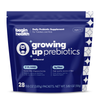Your Cart is Empty
Continue shoppingTop Sources of Probiotic Foods for Kids: Natural Foods for Constipation Support and Improved Digestion
Medically Reviewed by May Zhu, RDN | Published August 25, 2023
share this article

Probiotics play a crucial role in supporting healthy gut microbiome [7]. The condition of our kid’s microbiome can impact digestion, gut motility, and constipation [8]. Probiotics use prebiotics, like Begin Health’s Growing Up Prebiotics as fuel to create a flourishing and diverse microbiome. Just like how our kids’ bodies need the right nutrition to stay healthy, prebiotics are the nutrition probiotics need to set the foundation for a healthy gut. Incorporating a variety of probiotic-rich foods into your kiddos’ diet can help promote regular bowel movements [1]. Let’s explore some of the top sources of naturally probiotic-rich foods for kids, how much probiotics they provide, and review how they can help digestive health and provide additional constipation support for our kiddos.
How much probiotics are found in foods?
Probiotics identified by different strains of good bacteria. Some of the most common strains identified in probiotic products are [13]:
- Lactobacillus
- Bifidobacterium
- Saccharomyces
- Enterococcus
- Bacillus
Probiotics strains are measured by the Colony Forming Units (CFUs) which indicate the total number of cells that are alive and working. It’s important to note that a higher CFU number does not indicate that a health product has better health effects. Instead, review the quality of the bacteria strain by looking for well-researched strains. The two most researched strains of probiotics in kids include Lactobacillus and Bifidobacterium [11]. The recommended dosage will vary depending on your child’s age and health needs, but most studies show that doses ranging from 10 million to 10 billion CFUs may be beneficial to their health [14].
Daily reads to help your little ones lead happier and healthier lives.
Buy Now
Join the
Happy Gut Club
Yogurt (with live and active cultures)
Yogurt, specifically ones that indicate “live and active cultures” on the label will contain probiotics such as Lactobacillus and Bifidobacterium, which both support gut health in kids [11]. Bifidobacterium breve specifically has shown to be effective for increasing stool frequency in kids with functional constipation [2]. Opt for plain yogurt and add fresh fruits or a drizzle of pure maple syrup for natural sweetness.
For an extra boost, try mixing in our Growing Up Prebiotic into your kiddos favorite yogurt. Our prebiotic blend contains chicory root fiber, which can support softer stools and increase stooling frequency with daily consistent use [5]. Prebiotics feed beneficial gut bacteria in our digestive system to promote good gut health [6].
Kefir
Kefir is a fermented dairy product similar to yogurt but with a thinner consistency. It is rich in probiotics, including Lactobacillus and Bifidobacterium strains, which can improve friendly gut bacteria and provide constipation support for kids [2]. The fermented components in kefir also show additional health promoting characteristics linked to improving the microbiome and immunity [3]. For a nutritious probiotic boost, drink it on its own, mix into oatmeal or use it as a base for smoothies.
Sauerkraut
Sauerkraut is made from fermented cabbage and contains lactobacillus bacteria that aid in digestion and promote regular bowel movements [2]. Introduce small amounts of sauerkraut to your little one’s meals gradually to let their taste buds adjust to the tangy flavor. Incorporating sauerkraut in sandwiches or as a side dish can be an enjoyable way to include probiotics in their diet.
Kombucha
Kombucha is a fermented tea beverage that contains various strains of beneficial bacteria and yeast, such as Saccharomyces cerevisiae. Studies on Saccharomyces cerevisiae indicate that it is effective against different gastrointestinal diseases and contain anti-inflammatory properties [4].
It is important to note that kombucha does contain a small amount of natural alcohol due to the fermentation process, typically around 0.5% or less per serving. The industry standards in the United States require that store-bought kombucha must maintain less than 0.5% alcohol by volume, ABV, to be classified as a non-alcoholic beverage [9]. The percent ABV is comparable to the natural alcohol content found in yeast breads [10]. A standard serving is generally safe for kids ages 4 and above. Start with small amounts and monitor your kid’s reaction to ensure they tolerate it well. Opting for low-sugar options can help avoid excessive added sugar intake. The American Heart Association recommends no more than 25 grams of added sugars (6 tsp) per day for kids two years of age or older.
Kids’ Added Sugar Recommendations
|
Age |
Added Sugars |
|---|---|
|
0-2 years |
Not recommended for this age group |
|
2 years and up |
Less than 25 grams or 6 tsp per day (AHA recommended) or less than 10% of total daily calories consumed (CDC recommended) |
Fermented foods
Foods like pickles, tofu, and certain cheeses like feta [12] are all made through the process of fermentation, which uses bacteria or yeast to break down the food to naturally produce probiotics. Offering a variety of fermented foods to your kiddos can help them expand their palate and promote a healthy digestive system. For more information regarding the benefits of fermented foods for gut health, check out our blog post about Fermented Foods for Kids.
Comparing Probiotic Amounts (CFUs) in Foods
|
Food (serving) |
Types of Friendly Bacteria Strains (most commonly found) |
Probiotic Amount (in CFUs) |
|---|---|---|
|
Greek Yogurt, plain (1 cup serving*) |
Lactobacillus acidophilus Streptococcus thermophilus Lactobacillus delbrueckii subsp. bulgaricus |
2.5 billion CFUs |
|
Kefir, plain (1 cup*) |
Lactobacillus brevis Lactobacillus acidophilus Lactobacillus casei Lactococcus lactis Saccharomyces cerevisiae |
2.5 billion CFU |
|
Sauerkraut (1 cup) |
Leuconostoc mesenteroides Lactobacillus brevis Pediococcus pentosaceus Lactobacillus plantarum |
3 billion CFU |
|
Kombucha (1 cup*) |
Acetobacter, Bacillus, Starmerella and Komagataeibacter and Gluconobacter |
23 million |
|
Fermented foods, such as kimchi (½ cup) |
Weissella koreensis Lactobacillus sakei Lactobacillus graminis Weissella cibaria Leuconostoc mesenteroides |
11.5 billion CFUs |
Sourcess: [15, 16, 17, 18, 19, 20, 21]
*May vary by brand
Summary
As dietitians, we love encouraging variety when it comes to foods. The more diverse the diet, the more variety of good gut bacteria will be introduced into our little one’s bodies to support their gut health. Including different probiotic-rich foods in your kid’s diet can contribute to their digestive health and support constipation symptoms. Yogurt, kefir, kombucha, and fermented foods like sauerkraut are great sources of natural probiotics that offer gut health benefits. Support your kiddo’s probiotic intake by pairing it with prebiotics like Begin Health’s Growing Up Prebiotics, which acts as nourishment for probiotics. By incorporating these foods into their meals and snacks, we as parents can support our little one’s gut microbiome and overall well-being.
Remember to consult with your pediatrician or personal healthcare professional if your kiddo has specific dietary restrictions or concerns regarding the introduction of new foods. Your physician can help guide you along to make sure your little one is meeting their nutrition goals.

Author
May Zhu, RDN
Trending

Inc. Names Begin Health to Its 2025 List of the Fastest-Growing Private Companies in the Midwest
read now
Oxalates and Kids' Digestion: How High-Oxalate Foods Contribute to Constipation and Gut Discomfort
read now
5 Signs Your Toddler Needs a Poop Test
read now






